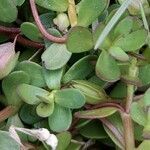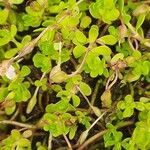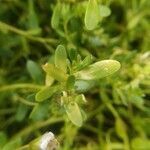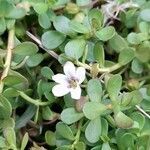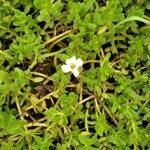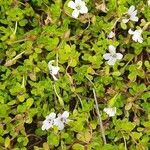Stems creeping and forming mats, glabrous; lvs oblanceolate to cuneate-obovate, entire, 0.5–2.5 cm, with a single midvein and a few obscure pinnately disposed lateral veins; fls solitary at the nodes on pedicels 1–2.5 cm; cal subtended by a pair of linear bractlets 2–3 mm; upper sep ovate to lanceolate, ca 6 × 2.5 mm; cor white to sometimes pink or blue, campanulate, 7–10 mm, glabrous within, the 5 lobes subequal, retuse; stamens included; stigma one, shallowly bilobed; 2n=64. Wet sandy shores on the coastal plain; se. Va. to Fla. and Tex., and widespread in the tropics. All summer. (Bramia m.)
Stems creeping, rooting at nodes, succulent, glabrous. Leaves sessile, oblong-oblanceolate, 0.8-2 cm X 3-6 mm, margin entire or rarely dentate, apex rounded. Flowers axillary. Pedicel 0.5-3.5 cm. Bracteoles 2, linear, below calyx. Sepals 5, ca. 5 mm; lower and upper sepals ovate-lanceolate; lateral 2 sepals lanceolate to linear. Corolla blue, purple, or white, 8-10 mm, obscurely 2-lipped. Stamens didynamous. Stigma capitate. Capsule narrowly ovoid, enveloped in persistent calyx, apex acute. Seeds yellow-brown, ellipsoid, truncate at one end, longitudinally striate. Fl. May-Oct.
A herb which grows in rice fields and lies along the ground. It grows 30 cm high. The stems are much branched. They form roots at the nodes. It can grow each year from seed or keep growing from year to year. The leaves are opposite and about 1.5 cm long by 1 cm wide. They are almost without stalks. The flowers contain both sexes. They occur singly in the axils of leaves. The flowers are on stalks about as long as the leaves. The flower tube has 5 lobes. They are white or light blue. The seeds are very small.
